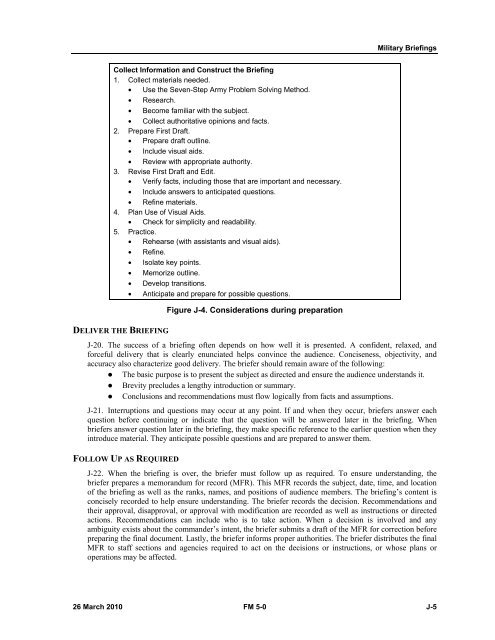FM 5-0, The Operations Process - Federation of American Scientists
FM 5-0, The Operations Process - Federation of American Scientists
FM 5-0, The Operations Process - Federation of American Scientists
You also want an ePaper? Increase the reach of your titles
YUMPU automatically turns print PDFs into web optimized ePapers that Google loves.
Military Briefings<br />
Collect Information and Construct the Briefing<br />
1. Collect materials needed.<br />
• Use the Seven-Step Army Problem Solving Method.<br />
• Research.<br />
• Become familiar with the subject.<br />
• Collect authoritative opinions and facts.<br />
2. Prepare First Draft.<br />
• Prepare draft outline.<br />
• Include visual aids.<br />
• Review with appropriate authority.<br />
3. Revise First Draft and Edit.<br />
• Verify facts, including those that are important and necessary.<br />
• Include answers to anticipated questions.<br />
• Refine materials.<br />
4. Plan Use <strong>of</strong> Visual Aids.<br />
• Check for simplicity and readability.<br />
5. Practice.<br />
• Rehearse (with assistants and visual aids).<br />
• Refine.<br />
• Isolate key points.<br />
• Memorize outline.<br />
• Develop transitions.<br />
• Anticipate and prepare for possible questions.<br />
DELIVER THE BRIEFING<br />
Figure J-4. Considerations during preparation<br />
J-20. <strong>The</strong> success <strong>of</strong> a briefing <strong>of</strong>ten depends on how well it is presented. A confident, relaxed, and<br />
forceful delivery that is clearly enunciated helps convince the audience. Conciseness, objectivity, and<br />
accuracy also characterize good delivery. <strong>The</strong> briefer should remain aware <strong>of</strong> the following:<br />
• <strong>The</strong> basic purpose is to present the subject as directed and ensure the audience understands it.<br />
• Brevity precludes a lengthy introduction or summary.<br />
• Conclusions and recommendations must flow logically from facts and assumptions.<br />
J-21. Interruptions and questions may occur at any point. If and when they occur, briefers answer each<br />
question before continuing or indicate that the question will be answered later in the briefing. When<br />
briefers answer question later in the briefing, they make specific reference to the earlier question when they<br />
introduce material. <strong>The</strong>y anticipate possible questions and are prepared to answer them.<br />
FOLLOW UP AS REQUIRED<br />
J-22. When the briefing is over, the briefer must follow up as required. To ensure understanding, the<br />
briefer prepares a memorandum for record (MFR). This MFR records the subject, date, time, and location<br />
<strong>of</strong> the briefing as well as the ranks, names, and positions <strong>of</strong> audience members. <strong>The</strong> briefing’s content is<br />
concisely recorded to help ensure understanding. <strong>The</strong> briefer records the decision. Recommendations and<br />
their approval, disapproval, or approval with modification are recorded as well as instructions or directed<br />
actions. Recommendations can include who is to take action. When a decision is involved and any<br />
ambiguity exists about the commander’s intent, the briefer submits a draft <strong>of</strong> the MFR for correction before<br />
preparing the final document. Lastly, the briefer informs proper authorities. <strong>The</strong> briefer distributes the final<br />
MFR to staff sections and agencies required to act on the decisions or instructions, or whose plans or<br />
operations may be affected.<br />
26 March 2010 <strong>FM</strong> 5-0 J-5















